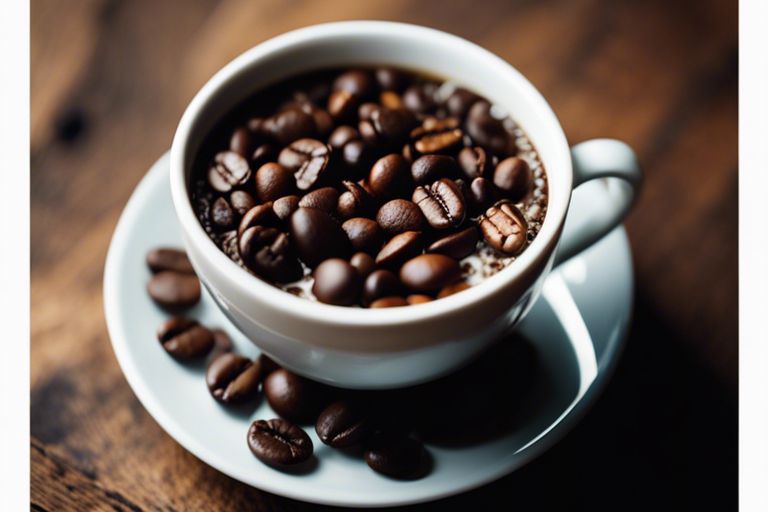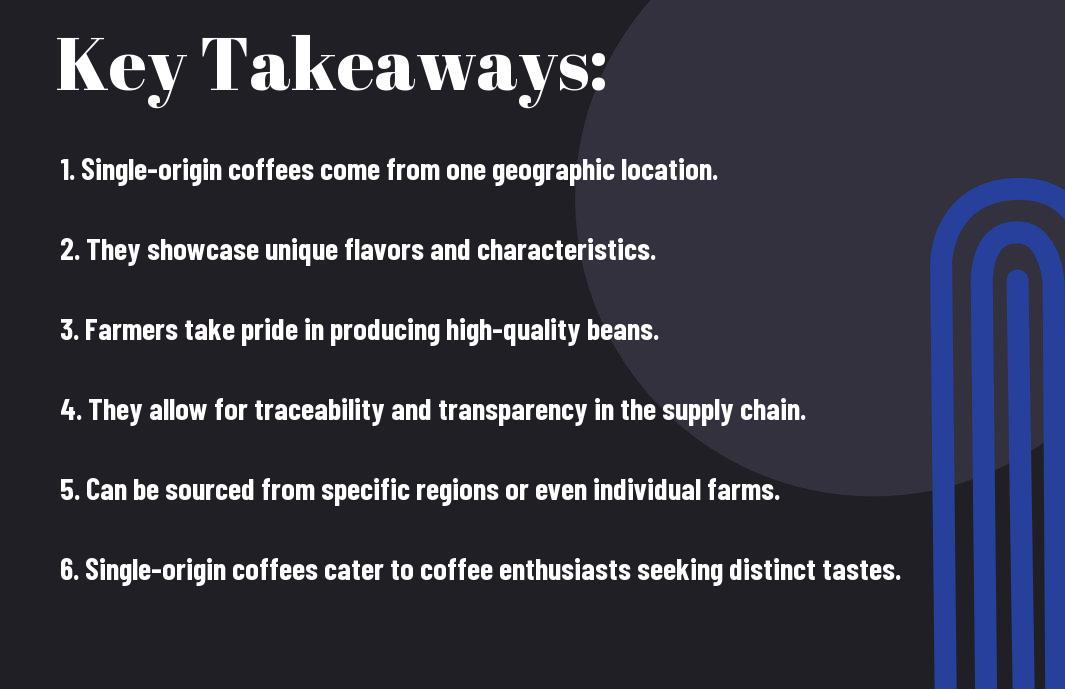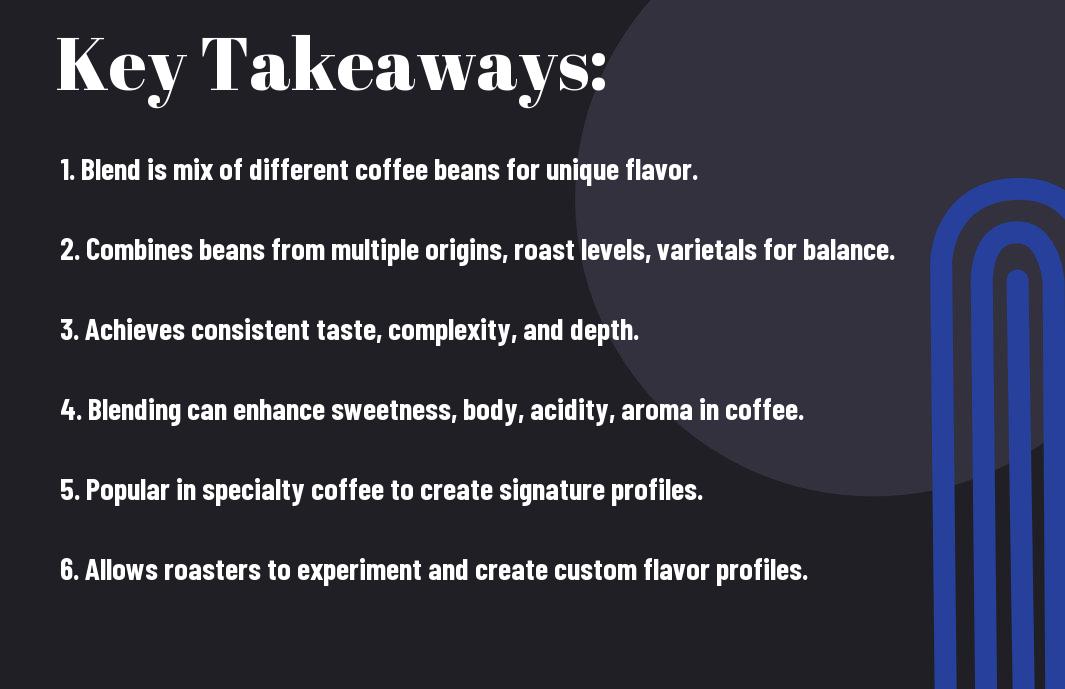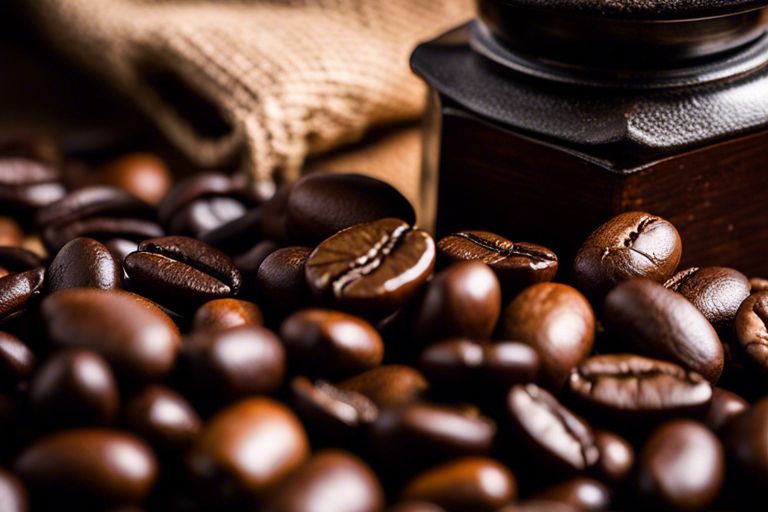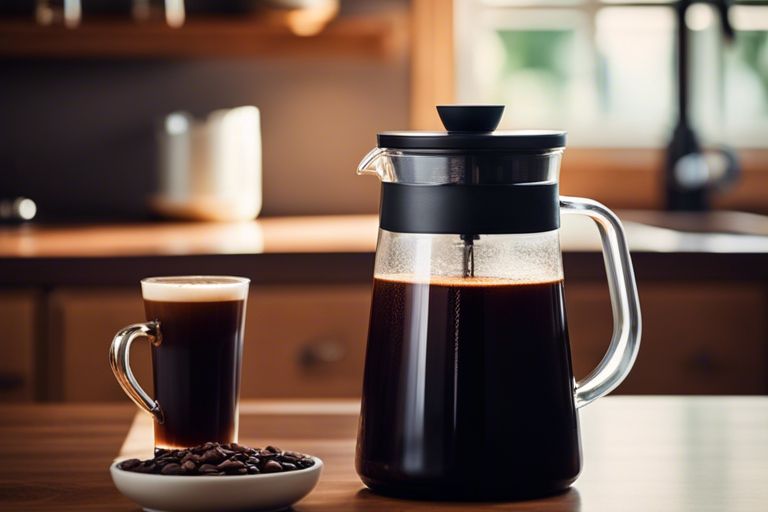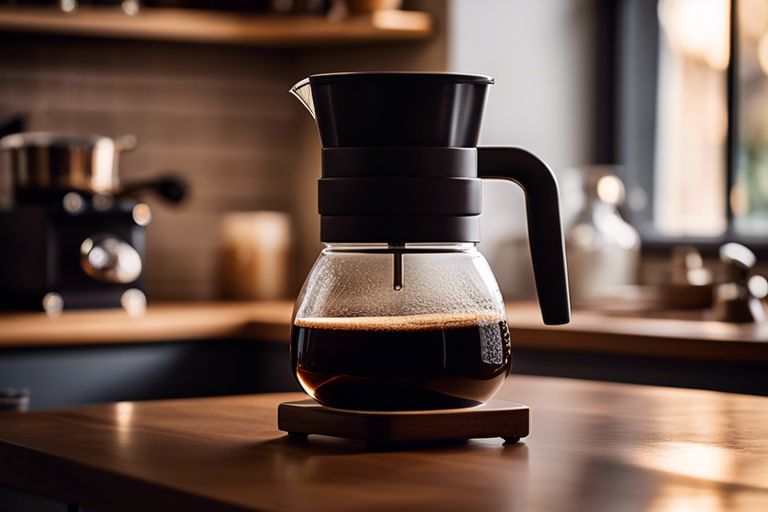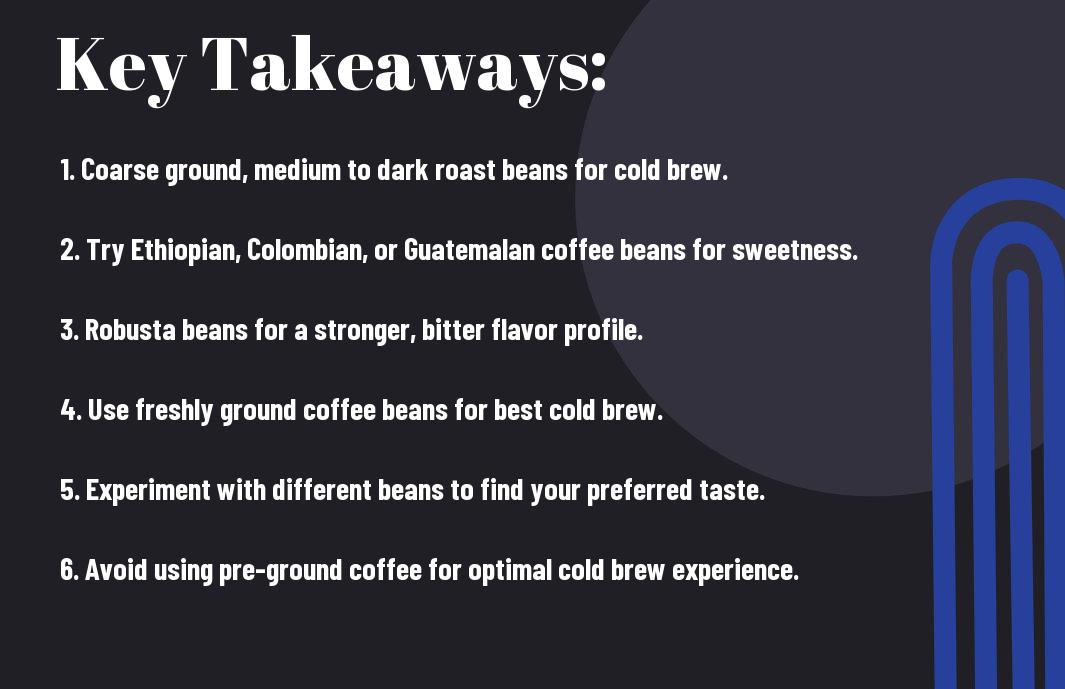Many coffee aficionados are familiar with the term “roast profile”, but what exactly does it mean? In the world of coffee, a roast profile refers to the specific details of how a batch of coffee beans is roasted, including factors such as temperature, time, and technique. Understanding the roast profile of a coffee can provide valuable insights into its flavor, aroma, and overall quality. In this blog post, we will explore into the intricacies of coffee roast profiles and explore how they impact the final cup of coffee that you enjoy.
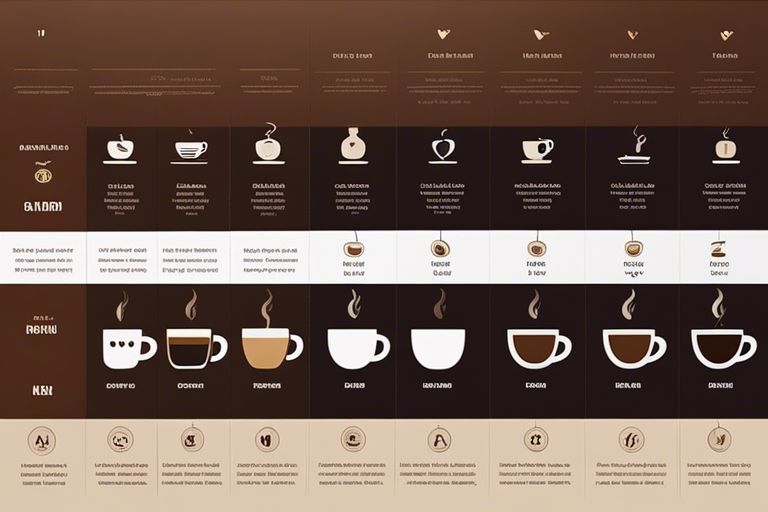
Key Takeaways:
- Coffee roast profile: Refers to the unique characteristics of a coffee bean that develop during the roasting process.
- Factors that influence roast profile: Include roasting time, temperature, and bean origin, which all play a role in shaping the flavor and aroma of the final product.
- Roast levels: Range from light to dark, each offering a different taste experience – lighter roasts tend to be more acidic and retain more of the bean’s original flavors, while darker roasts are richer and more intense.
- Development time ratio (DTR): Measures the duration between the beginning of the roast and the first crack, helping roasters achieve consistency in their batches.
- Understanding roast profiles: Is important for coffee enthusiasts who want to appreciate the complexity of their brews and explore different flavor profiles based on their preferences.
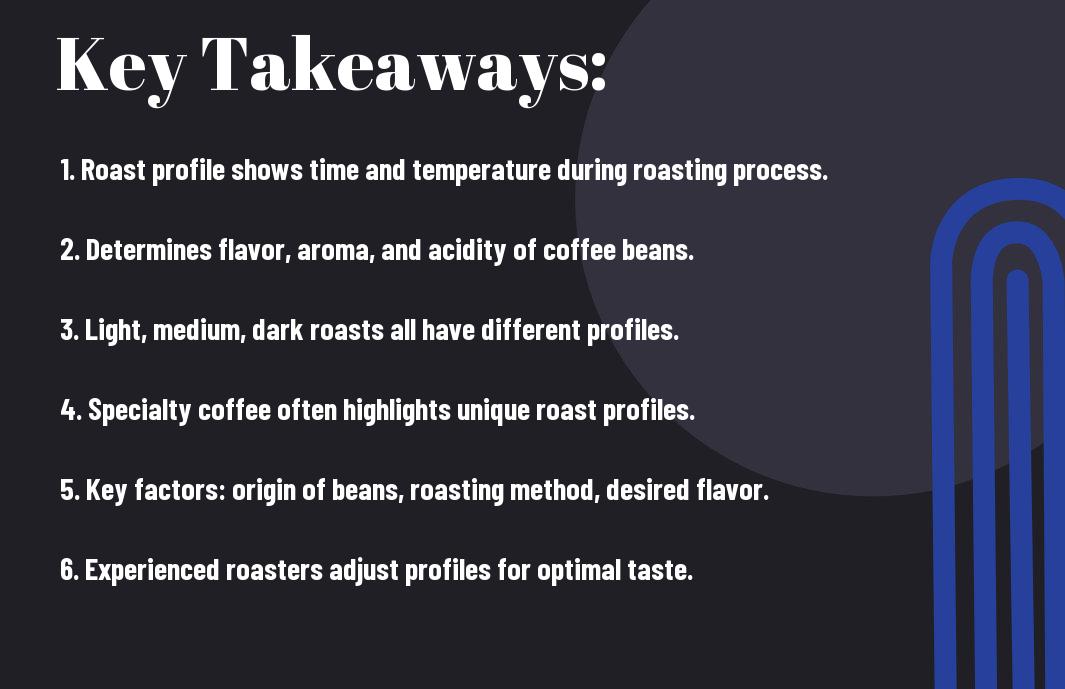
Defining Coffee Roast Profile
A coffee roast profile is a detailed record of the roasting process for a particular batch of coffee beans. It encompasses various factors like roast level, time and temperature of roast, and the overall flavor development during the roasting process. Roast profiling is necessary for achieving consistency in flavor among different batches of coffee beans.
The Concept of Roast Level
On the topic of roast level, it refers to the degree of roast applied to coffee beans during the roasting process. Roast levels can range from light to dark, with each level impacting the flavor and aroma of the brewed coffee. Lighter roasts tend to preserve more of the beans’ natural flavors, while darker roasts develop rich, caramelized notes.
The Role of Roasting in Coffee Production
An integral part of the coffee production process, roasting plays a crucial role in transforming green coffee beans into the aromatic beans we love to brew. During roasting, the beans undergo chemical reactions that affect their flavor profile, acidity levels, and body. The skilled roaster monitors and adjusts various parameters to achieve the desired roast profile that brings out the best in the beans.
Coffee beans contain various compounds that contribute to their flavor, and roasting acts as a catalyst for unlocking these flavors. Through the application of heat, the beans undergo Maillard reactions and caramelization, leading to the development of complex flavors and aromas. The duration and intensity of the roast significantly impact the final taste of the brewed coffee, making roast profiling an art form that requires precision and expertise.
The Science Behind Roast Profiles
Chemical Reactions During Roasting
Roasting coffee beans is a complex process that involves a series of chemical reactions. According to Roast Profiling, during the roasting process, several key reactions take place, including caramelization, Maillard reaction, and pyrolysis. These reactions are responsible for the development of aromas and flavors in the coffee beans.
Maillard Reaction and Flavor Development
An necessary reaction that occurs during the roasting of coffee beans is the Maillard reaction. This reaction is a complex chemical process between amino acids and reducing sugars that results in the browning of the beans and the development of rich flavors and aromas. The Maillard reaction is crucial in creating the desirable taste profile of a well-roasted coffee bean.
During the Maillard reaction, hundreds of different flavor compounds are created, resulting in the wide array of flavors found in coffee. These compounds contribute to the complexity and depth of flavor in the final brewed cup. It is necessary for roasters to understand the Maillard reaction and how it impacts the flavor development of coffee beans to achieve the desired roast profile.
The Impact of Temperature and Time on Roast Profile
| Temperature | Time |
| Higher temperatures can result in faster roast development and more pronounced acidity. | Extending the roast time can help develop flavors and increase body in the coffee. |
Time also plays a crucial role in determining the final roast profile of coffee beans. The duration for which the beans are roasted can significantly impact the flavor, aroma, and body of the coffee. In general, longer roast times tend to result in darker roasts with more developed flavors, while shorter roast times are preferred for preserving the unique characteristics of the beans.
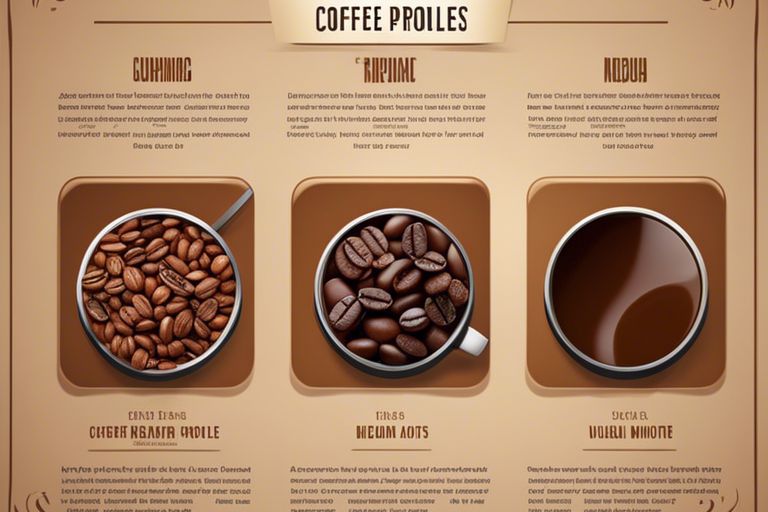
Types of Coffee Roast Profiles
For coffee enthusiasts seeking to explore the diverse world of coffee roast profiles, understanding the various types can enhance the appreciation of the nuances in flavor and aroma. Here are some common types of coffee roast profiles categorized based on their roasting levels:
- Light Roast
- Medium Roast
- Dark Roast
- Espresso Roast
Perceiving the distinctions between these roast profiles can provide insights into the unique characteristics they bring to the cup.
Light Roasts: Bright and Fruity
With a light roast profile, coffee beans are roasted at lower temperatures for a shorter duration, preserving their natural flavors and acidity. These roasts are often characterized by their bright, fruity, and floral notes, making them popular among those who prefer a more delicate and complex flavor profile in their coffee.
Medium Roasts: Balanced and Smooth
An excellent balance between the acidity and body of the coffee beans is achieved with a medium roast profile. These roasts offer a smooth and well-rounded taste, with a pleasant aroma that is not too overpowering. Plus, they retain some of the bean’s original characteristics while also showcasing caramel and chocolate undertones.
For those who enjoy a richer and more intense coffee experience, dark roast profiles are the way to go. These beans are roasted at higher temperatures for a longer period, resulting in a dark, bold flavor with smoky, caramelized notes. Dark roasts often have a bittersweet aftertaste and a robust body, making them ideal for those who prefer a stronger brew.
Another popular roast profile is the espresso roast, specially crafted to bring out the best flavors when brewed as espresso. With a dark and oily appearance, these beans are roasted longer to accentuate their intense and complex flavors, which can range from spicy and earthy to nutty and sweet. Espresso roasts are perfect for creating espresso shots with a rich crema and a full-bodied taste, ideal for coffee lovers who appreciate a concentrated and flavorful cup.
Roasts profiles play a significant role in the final taste and experience of the brewed coffee, offering a range of flavors to suit every palate.
Factors Influencing Roast Profile
Once again, there are several key factors that can influence a coffee roast profile. Understanding these factors is crucial for achieving the desired flavor profile in your cup of coffee. Let’s explore some of the most significant influencers below:
Coffee Bean Origin and Variety
Variety plays a crucial role in determining the flavor profile of a coffee bean. Different coffee varieties, such as Arabica or Robusta, have distinct flavor profiles based on where they are grown. The altitude, climate, soil composition, and processing methods of the region where the beans are cultivated all contribute to the unique flavors that are present in the coffee.
- The origin of the coffee bean can influence the overall flavor profile, with beans from different regions offering distinct taste characteristics.
- The variety of the coffee bean, such as Arabica or Robusta, can also impact the flavor notes present in the final cup of coffee.
Thou, it’s important for roasters to understand how the origin and variety of the beans will interact with the roasting process to achieve the desired flavor profile.
Roasting Techniques and Equipment
Originating from the equipment used and the techniques applied during the roasting process can significantly impact the roast profile. Roasters may use different types of roasting machines, such as drum roasters or air roasters, each imparting unique characteristics to the coffee beans. The temperature and duration of the roast, as well as the airflow and drum speed, are all critical factors that can influence the final flavor of the coffee.
Roasters must carefully consider the roast levels, development time, and cooling methods to ensure the flavors are optimized and consistent across batches. Understanding how different roasting techniques and equipment can affect the overall flavor profile is important for achieving a high-quality roast.
Roastmaster’s Skill and Experience
Bean roastmasters play a vital role in determining the final flavor profile of the coffee beans through their skill and experience. A skilled roastmaster will be able to make informed decisions during the roasting process, such as adjusting the heat and airflow to bring out the desired flavors in the beans. Experience plays a crucial role in understanding how different beans will react to various roasting techniques and equipment, allowing the roastmaster to create unique and exceptional roast profiles.
Roastmasters must constantly refine their craft through practice and experimentation to hone their skills and create exceptional coffee roast profiles that delight consumers with every sip.
The Art of Roast Profiling
Your coffee roast profile is like a fingerprint, unique to each batch of beans and defining the flavor nuances in your cup. Mastering the art of roast profiling involves a delicate balance of time, temperature, and technique to bring out the best in your beans.
Balancing Flavors and Acidity
Profiling the roast to balance the flavors and acidity of the coffee is a crucial step in the process. By adjusting the roast time and temperature, roasters can amplify certain flavor notes, enhance acidity, or create a more balanced profile that appeals to a wider range of coffee drinkers.
Creating a Signature Roast Profile
An artful roaster can create a signature roast profile that sets their coffee apart from the rest. By carefully selecting the origin of the beans, understanding their unique characteristics, and experimenting with different roast levels, a roaster can develop a distinct flavor profile that customers will come back for time and time again.
Roast profiling involves a deep understanding of the beans being roasted and the desired flavor profile. By fine-tuning the roast level, time, and temperature, roasters can bring out the best in each batch of beans, creating a signature roast that reflects their skill and expertise.
Experimenting with Different Roast Levels
On the journey to perfecting your roast profile, experimenting with different roast levels is key. Whether you prefer a light, medium, or dark roast, each level brings out unique flavor profiles in the beans. By exploring the full spectrum of roast levels, you can discover new and exciting flavors hidden within your coffee beans.
Flavors evolve with each degree of roast, from bright and fruity notes in a light roast to rich and smoky undertones in a dark roast. By experimenting with different roast levels, you can unlock a world of possibilities and create a coffee roast profile that is truly one-of-a-kind.
Roast Profile and Brewing Methods
How Roast Profile Affects Drip Brewing
Many coffee enthusiasts are familiar with drip brewing, a popular method that involves hot water dripping through a bed of ground coffee. The roast profile plays a crucial role in the final flavor of the drip coffee. Lighter roasts tend to have more pronounced acidity and fruity notes, making them ideal for drip brewing methods that highlight these characteristics.
For those who prefer a milder cup with balanced flavors, medium roasts are a great choice for drip brewing. The medium roast brings out a harmony of flavors with a moderate level of acidity and sweetness, creating a well-rounded and pleasant taste experience.
The Impact of Roast Profile on Espresso
Roast profile also significantly impacts the quality of espresso, a concentrated coffee brewing method that originates from Italy. The espresso brewing process requires a fine grind size and high pressure, which extracts flavors differently from other brewing methods. A darker roast profile is commonly preferred for espresso due to its rich and intense flavors that can stand out even when mixed with milk in popular espresso-based drinks like lattes and cappuccinos.
With the right roast profile, espresso can exhibit a bold and robust flavor profile that resonates with coffee lovers seeking a strong and full-bodied experience. The darker roast brings out caramelized and smoky notes, which complement the velvety texture achieved through the espresso extraction process.
Roast Profile and Pour-over Brewing
Profile
Summing up
From above, we’ve examined into the intricate world of coffee roast profiles, understanding how different factors such as time, temperature, and airflow can affect the final taste of our beloved beverage. Whether you’re a coffee aficionado or just starting on your coffee journey, mastering the roast profile is imperative to unlocking the true potential of your beans. For further reading on achieving the perfect cup of coffee through roast profile consistency, check out Perfect Cup: A 2022 Essential Guide to Coffee Roast Profile Consistency.
FAQ
Q: What is a coffee roast profile?
A: A coffee roast profile refers to the detailed record of how a particular coffee bean was roasted, including the time, temperature, and other variables that influence the final flavor and aroma of the brew.
Q: Why is understanding coffee roast profiles important?
A: Understanding coffee roast profiles is crucial because it helps coffee enthusiasts and professionals alike to replicate and adjust roasting methods to achieve specific flavor profiles, ensuring consistency and quality in the final cup of coffee.
Q: What are the key components of a coffee roast profile?
A: The key components of a coffee roast profile include the origin of the coffee bean, the roasting time and temperature, the rate of temperature increase, the cooling process, and any other specific notes about the roasting process.
Q: How does the roast profile affect the taste of the coffee?
A: The roast profile directly influences the taste of the coffee by determining the level of caramelization and development of flavors in the bean. Lighter roasts tend to highlight the bean’s natural flavors, while darker roasts have a richer and bolder taste with less acidity.
Q: Can coffee roast profiles vary between different coffee beans?
A: Yes, coffee roast profiles can vary significantly depending on the origin, variety, and quality of the coffee bean. Different beans may require specific roasting techniques to bring out their unique characteristics and flavors.
What are the origins of coffee

